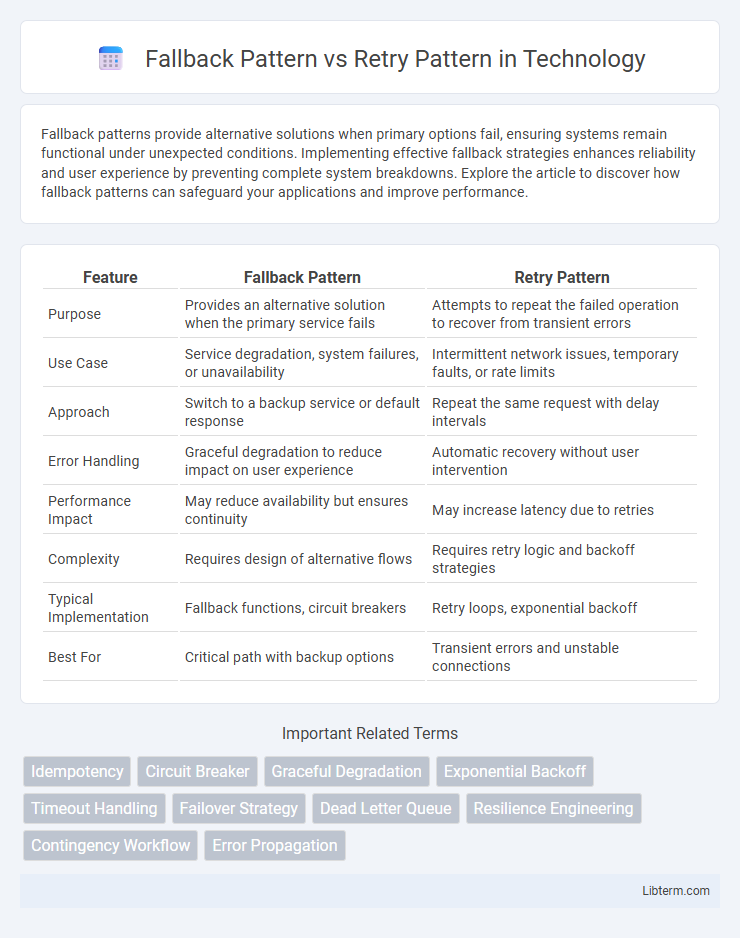Fallback patterns provide alternative solutions when primary options fail, ensuring systems remain functional under unexpected conditions. Implementing effective fallback strategies enhances reliability and user experience by preventing complete system breakdowns. Explore the article to discover how fallback patterns can safeguard your applications and improve performance.
Table of Comparison
| Feature | Fallback Pattern | Retry Pattern |
|---|---|---|
| Purpose | Provides an alternative solution when the primary service fails | Attempts to repeat the failed operation to recover from transient errors |
| Use Case | Service degradation, system failures, or unavailability | Intermittent network issues, temporary faults, or rate limits |
| Approach | Switch to a backup service or default response | Repeat the same request with delay intervals |
| Error Handling | Graceful degradation to reduce impact on user experience | Automatic recovery without user intervention |
| Performance Impact | May reduce availability but ensures continuity | May increase latency due to retries |
| Complexity | Requires design of alternative flows | Requires retry logic and backoff strategies |
| Typical Implementation | Fallback functions, circuit breakers | Retry loops, exponential backoff |
| Best For | Critical path with backup options | Transient errors and unstable connections |
Introduction to Fallback and Retry Patterns
The Fallback Pattern ensures system resilience by providing an alternative response or default value when a primary operation fails, maintaining continuity despite errors. The Retry Pattern improves reliability by attempting the same operation multiple times after failures, often with delay intervals to handle transient issues. Both patterns are crucial for building fault-tolerant software systems, with Fallback focusing on graceful degradation and Retry emphasizing repeated attempts to achieve success.
Understanding Resilience in Software Systems
Fallback Pattern enhances software resilience by providing alternative responses when primary services fail, ensuring continuous functionality under failure conditions. Retry Pattern boosts robustness by automatically attempting failed operations multiple times, addressing transient errors without immediate failure escalation. Both patterns complement each other in designing fault-tolerant systems that maintain stability and improve user experience during unpredictable service disruptions.
Defining the Retry Pattern
The Retry Pattern involves automatically attempting an operation multiple times upon failure, with a predefined number of retries and configurable delays between attempts to enhance fault tolerance. It is particularly useful in handling transient failures such as network timeouts or service unavailability by increasing the likelihood of success without immediate user intervention. This pattern contrasts with the Fallback Pattern, which provides an alternative response or logic when the main operation fails, focusing on graceful degradation rather than repeated attempts.
Defining the Fallback Pattern
The Fallback Pattern provides an alternative execution path or default response when a primary service or component fails, ensuring system resilience and continuity. It is commonly used in distributed systems to handle service outages gracefully by returning cached data, default values, or alternative service responses. This pattern reduces the impact of failures on user experience by preventing complete system breakdowns.
Key Differences Between Fallback and Retry Patterns
The Fallback Pattern provides an alternative response or action when a primary service fails, ensuring continuity by switching to a backup method, while the Retry Pattern attempts to resend a failed operation multiple times before considering it a failure. Fallback prioritizes system resilience by degrading gracefully without user interruption, whereas Retry emphasizes error recovery by overcoming transient faults through repeated attempts. These patterns differ fundamentally in their approaches: fallback sacrifices operation completion for stability, while retry invests in attempting success before fallback or failure handling occurs.
When to Use the Retry Pattern
The Retry Pattern is appropriate when transient faults or temporary issues, such as network timeouts or brief service unavailability, occur and a subsequent attempt has a high chance of success. Use the pattern in scenarios where idempotent operations can be safely repeated without adverse effects, minimizing the risk of duplications or inconsistent states. It is essential to implement exponential backoff and jitter to avoid overwhelming the target system during repeated retry attempts.
When to Use the Fallback Pattern
Use the Fallback Pattern when system reliability is critical, and a secondary option is needed to maintain service continuity during failures. It provides an alternative response or default value to avoid complete service disruption, especially in distributed or microservices architectures where dependent services may be intermittently unavailable. This pattern is ideal for improving user experience in scenarios involving transient faults or partial system outages without retrying the same failing request repeatedly.
Combining Fallback and Retry for Robust Solutions
Combining the Fallback Pattern with the Retry Pattern enhances application resilience by first attempting multiple retries on transient failures before engaging a fallback mechanism to maintain service availability. This strategic integration reduces downtime and improves user experience by seamlessly handling intermittent issues while providing alternative responses when retries are exhausted. Implementing a coordinated retry logic followed by a fallback process ensures robustness in distributed systems prone to network latency or partial service outages.
Best Practices for Pattern Implementation
Implementing the Fallback Pattern requires defining a reliable secondary action or default response to maintain system stability when the primary service fails, ensuring minimal user disruption and clear error handling. The Retry Pattern best practice involves setting exponential backoff strategies with capped retry attempts to avoid overwhelming services while balancing responsiveness and resource consumption. Combining these patterns effectively enhances resilience by allowing controlled retry attempts followed by fallback mechanisms when failures persist, optimizing system reliability and user experience.
Conclusion: Choosing the Right Pattern
Choosing the right pattern depends on system requirements and failure scenarios; the Retry Pattern is ideal for transient faults where repeating an operation may succeed, while the Fallback Pattern provides a backup solution when the primary service fails persistently. Implementing retries reduces temporary errors and improves reliability without involving alternate services, whereas fallbacks ensure continuity by switching to secondary processes or degraded modes. Evaluating failure types, response time tolerance, and service dependencies is crucial to selecting the optimal pattern for resilient and fault-tolerant system design.
Fallback Pattern Infographic

 libterm.com
libterm.com